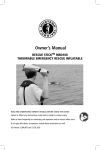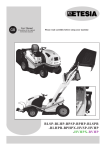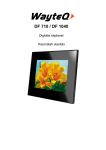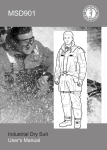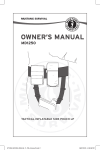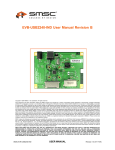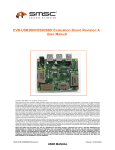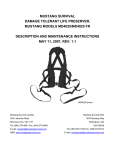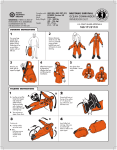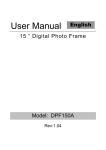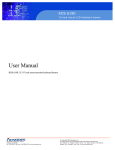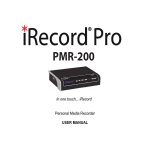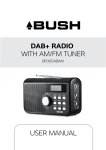Download Owner`s Manual
Transcript
Owner’s Manual RESCUE STICKTM MRD100 THROWABLE EMERGENCY RESCUE INFLATABLE READ AND UNDERSTAND OWNER'S MANUAL BEFORE USING THIS DEVICE Failure to follow user Instructions could result in death or serious injury. Refer to them frequently for continuing safe operation and to instruct other users. If you pass this device to someone; include these instructions as well. US Patents 7,004,807 and 7,128, 629 CONTENTS Page i Symbols 1 Introduction 1 General Safety Rules 2 Specific Safety Rules 2 Inspection, Storage and Maintenance 3 Storage 3 Operation 4 Re-arming and Repacking 4 Drying and Deflating 5 Disassembly 6 Re-arming 7 Repacking 8 Training 9 Service 9 Limited Warranty SYMBOLS Symbol Signal Meaning WARNING: Indicates a potentially hazardous situation, which, if not avoided, could result in death or serious injury. CAUTION: Indicates a potentially hazardous situation, which, if not avoided, could result in minor or moderate injury. FIGURE 1 Indicates that failure to read and understand the user manual READ AND UNDERSTAND could result in death or serious injury. INSTRUCTION MANUAL: WARNING: Indicates a potentially hazardous situation, which, if not avoided, could result in death or serious injury. CO2 cylinders are under extreme pressure. Use caution when handling them. When servicing, wear protective eye wear. DO NOT REMOVE PRIOR TO SALE. i Rescue Stick™ Owner’s Manual INTRODUCTION Congratulations on your purchase of the Mustang Survival Rescue Stick™, which provides rapid flotation assistance to a person at risk of drowning. Simply remove the baton shaped Rescue Stick™ from its protective container and throw near the victim. Once contact is made with the water, it inflates in seconds to a large horseshoe shape, providing 35lbs of buoyancy, keeping a person afloat and their head above water until help arrives. WARNING: Do not attempt to use or service this product until you read and completely understand the owner's manual. Only a qualified service technician should perform service or repairs, other than those found in this manual. The Rescue Stick™ is a portable water rescue flotation device that you throw to provide emergency flotation to a conscious victim. When the Rescue Stick™ is thrown into the water, it automatically inflates into a flotation device. Measuring only 14” in length and weighing less than 1 lb, the Rescue Stick™ is the most compact water rescue tool available. Easily stowed in a boat, vehicle, backpack or by the pool so that it will be accessible when and where you need it. General Safety Rules WARNING: Read and understand all instructions. Failure to follow all instructions listed below and throughout this user manual may result in improper use and/or damage to the device making it unusable or result in death or serious personal injury. Know Your Rescue Stick™ Read the user manual carefully. Learn the device applications and limitations as well as the specific potential hazards related to this device. This device uses CO2 gas, within the handle cartridge, to inflate the flotation device. Read and understand the handling and care of CO2 cylinders. Protect Your Rescue Stick™ Store the Rescue Stick™ in its original storage container in a clean dry area. Keep this device away from fuels, oils, acids and from sharp or pointed objects. Keep Away From Heat and Moisture Avoid prolonged exposure to excessive humidity or high temperatures in excess of 140º F or 60ºC. Inspect Device Periodically If damaged, do not use. For factory validation, replacement parts or return authorization: MUSTANG SURVIVAL CUSTOMER SERVICE 3870 MUSTANG WAY BELLINGHAM, WA 98226 USA TEL: (360) 676-1782 FAX: (360) 676-5014 E-MAIL: [email protected] Keep Up Routine Maintenance Replace bobbin every three (3) years (normal use) or once a year (commercial use). Rescue Stick™ Owner’s Manual 1 Dispose of Gas Cylinders Only When Empty SPECIFIC SAFETY RULES WARNING: CO2 cylinders are under EXTREMELY high pressure. A puncture or release of freezing liquid CO2 (-50ºF) could result in serious injury or death. CO2 cylinders and cartridges should be handled with extreme care by responsible adults. Installing a faulty or spent cylinder will result in the failure of the Rescue Stick™ to operate and inflate the flotation device. NEVER throw the Rescue Stick™ directly at the victim in the water. Throw to an area NEAR the victim. Inspect the new cylinder and make sure it has no holes or scratches on the face or rough threads. ALWAYS wear eye protection when changing CO2 cylinders. CAUTION: This device is water actuated. Trapping moisture inside the storage container could case premature inflation. Excessive heat coupled with trapped moisture may accelerate this condition. Ensure that all of the components and the container of your device are clean and COMPLETELY DRY before re-arming and/or returning the device to its storage container. Stow Cool Do not heat the device or CO2 cylinders over 140ºF or 60ºC. DO NOT incinerate or leave in confined spaces with direct sunlight such as a car dashboard. Keep Away From Children INSPECTION, STORAGE AND MAINTENANCE READINESS CHECKLIST Inspect inflation assembly and cell on a clean, dry, flat surface. If any obvious defects such as: cracks, breaks, punctures or cuts are observed, STOP do not use this device. Factory inspection and validation is recommended. The green band inside the clear cap of the inflation mechanism should be clearly visible. If band is red, STOP do not use this device until a new handle cartridge and bobbin have been installed. Ensure the cylinder has not been pierced. See RE-ARMING instructions. Manual actuation lever should be in the upright closed position with green indicator clip locked in place. The inflation cell should be clean, completely dry and fully deflated. The oral tube should be capped in the sealed position, not in the inverted deflate position. Pressure check: Inflate the flotation cell through the oral tube until the cell is very firm to the touch. Leave undisturbed in a clean, dry area for 24 hours. There should be no 2 Rescue Stick™ Owner’s Manual significant loss of pressure after 24 hours. NOTE: If cell or oral tube is not holding pressure, factory inspection is recommended. STORAGE Store the Rescue Stick™ in its original storage container in a clean dry area. Avoid prolonged exposure to excessive humidity or high temperatures in excess of 140º F or (60º C). Keep this device away from fuels, oils, and acids and from sharp or pointed objects. Replace bobbin every three (3) years (normal use) or once a year (commercial use). With proper care and storage, this device's water sensing element has an approximate shelf life of three years. Your Rescue Stick™ can be re-armed. After expiration, use re-arm kit MA7206 and follow RE-ARMING and REPACKING instructions. WARNING: Failure to inspect, service and maintain your Rescue Stick™ could make it less effective and/or damage the device making it unusable. A poorly maintained Rescue Stick™ could result in serious personal injury and a lost opportunity to save a life. Take care of your Rescue Stick™; someone is counting on it. OPERATION In a water rescue situation, time is against you. The Rescue Stick™ is a quick and simple emergency flotation device to be used when a conscious victim is in the water. This device can be thrown, near a conscious victim who requires temporary flotation until further rescue efforts begin. INSTRUCTIONS FOR USE Step 1 - Throw the device in area near the victim. Step 2 - The device automatically inflates when immersed in water. Step 3 - The device can also be manually inflated by pulling “jerk to inflate” tab. FIGURE 2 WARNING: Unless you are a water rescue professional, entering the water to rescue a person can be a fatal mistake. Water conditions and the desperate acts of a victim can easily make you a victim as well. REACH, THROW, ROW; BUT DON’T GO. Reach someone in the water with a pole, branch, paddle, ladder and many other things. Throw them anything that floats, such as a ball, milk jugs, ice chest, inner tube, PFD or Rescue Stick™. Rescue Stick™ Owner’s Manual 3 RE-ARMING AND REPACKING WARNING: CO2 cylinders are under EXTREMELY high pressure. Puncture or accidental release could result in serious injury or death. CO2 cylinders should be handled with extreme care by responsible adults. Installing a faulty or spent cylinder will result in the failure of this device to inflate. Inspect the new cylinder to ensure it has no holes or scratches on the face or rough threads. WARNING: To properly RE-ARM AND REPACK this device, you must understand and follow the sequences and steps provided. DRYING AND DEFLATING YOUR DEVICE Step 1 - Allow storage container to completely dry out. Step 2 - Hang inflated cell up by one of its handles inside a warm, dry and clean area to completely dry out. An inflated cell dries more thoroughly. Keep away from excessive heat or open flame. Step 3 - To deflate the dry cell: remove cap on oral tube, invert cap and use inverted cap to depress the internal Pressure Relief Valve (PRV) located at the end of the oral tube. Hug and collapse the cell while depressing the pressure release valve. Continue to collapse the cell onto itself until virtually all the air is evacuated (Fig. 4). FIGURE 4 FIGURE 3 ORAL INFLATOR CAP ORAL TUBE INFLATOR CAP HANDLE JERK TO INFLATE TAB Step 4 - Lay the cell down flat on a clean dry table, printed side up and the open end facing you Fig.7). Step 5 - Starting from the left cell leg, tightly roll up the cell in the clockwise direction until you reach the oral tube (Fig. 5). Tip: wrap cell around detached handle and roll to aid in deflation. 4 Rescue Stick™ Owner’s Manual Step 6 - Evacuate any air remaining in cell (Fig. 6). FIGURE 5 FIGURE 6 Step 7 - Follow the RE-ARMING and REPACKING instructions. DISASSEMBLY If your device has been inflated, the inflation cell must be inspected (see INSPECTION, STORAGE AND MAINTENANCE), completely deflated, clean and COMPLETELY DRY before re-arming and repacking. Step 1 - Unpack, or open, the Rescue Stick™ assembly on a clean, flat, and dry surface so that the inflator is visible (Fig. 7). FIGURE 7 FIGURE 8 Step 2 - Remove the handle, containing the discharged CO2 cylinder, by firmly rotating counterclockwise (Fig. 8). To ensure that you do not re-install a used cylinder, discard immediately. If cylinder is discharged, replace with new handle. Ensure the cylinder has not been pierced. See RE-ARMING. Rescue Stick™ Owner’s Manual 5 Step 3 - Remove clear inflator cap by turning counter-clockwise (Fig. 9). FIGURE 9 FIGURE 10 Step 4 - Remove the bobbin from the cap. Discard the bobbin. Check the housing to be sure it is clear of debris, clean and dry (Fig. 10). CAUTION: The bobbin body may remain in the housing or in the cap assembly when you remove the cap. The bobbin body must be removed prior to assembly. RE-ARMING WARNING: CO2 cylinders are under EXTREMELY high pressure. Failure to install a bobbin prior to the installation of the CO2 cylinder could result in a premature puncture of the CO2 cylinder. CO2 cylinders contain freezing liquid CO2 at -50ºF which could cause serious skin burns and eye injury. A punctured unrestrained CO2 cylinder can travel at high velocities which could cause serious injury or death. WARNING: In order to properly re-arm the device, steps 1 - 4 must be followed exactly. IMPORTANT: Bobbin must be installed into the inflator HOUSING before screwing on the inflator cap. IMPORTANT: Check the date on the bobbin in the re-arm kit. The date should not be more than three (3) years previous to today’s date. If more than three (3) years, DO NOT USE and discard the expired bobbin. Step 1 - To install a valid bobbin, align the slots on the bobbin with those on the housing. The bobbin will slide in easily if installed correctly (Fig. 11). FIGURE 11 FIGURE 12 Step 2 - Install cap by screwing clockwise until it meets the housing shoulder (Fig. 12). 6 Rescue Stick™ Owner’s Manual NOTE: Ensure there is no gap between the cap and the inflator shoulder. Step 3 - Install new handle (CO2 cylinder) by rotating clockwise into inflator until firmly secured (Fig. 13). Ensure the cylinder has not been pierced. FIGURE 13 FIGURE 14 Step 4 - Check to be sure service indicator is green inside clear cap and the green indicator clip is firmly attached to the activation lever (Fig. 14). REPACKING Step 1 - Lay flat on clean dry surface, handle side up (Fig. 15). FIGURE 15 FIGURE 16 Step 2 - Fold the left cell lobe under the right cell lobe at the FOLD#1 line (Fig. 16). Ensure the “Jerk to Inflate” tab is placed beside the cell. Step 3 - With your left hand, fold the J end over to form the letter I at the FOLD#2 line (Fig. 17). FIGURE 17 FIGURE 18 Jerk to Inflate Tab Step 4 - Fold the cell, at the FOLD#3 line, down to the inflator and hold down with your right hand (Fig. 18). Rescue Stick™ Owner’s Manual 7 Step 5 - With your left hand, fold the bottom of the cell over the handle, at the FOLD#4 line. Ensure “Jerk to Inflate” tab is placed beside the cell (Fig. 19). FIGURE 19 FIGURE 20 Jerk to Inflate Tab Step 6 - Tightly roll up the cell starting from the handle end and rolling forward. Ensure “Jerk to Inflate” tab is outside cell when rolling up (Fig. 20). Step 7 - Place the handle through the cover loop. Place the rolled cell into cover and close the cover by fastening the Velcro strips. Ensure “Jerk to Inflate” tab is outside the cover and accessible (Fig. 21). FIGURE 21 FIGURE 22 Jerk to Inflate Tab Cover Loop Step 8 - Cover tether should be made snug to the handle. Before returning the device to its storage container, ensure that the container is clean and completely dry (Fig. 22). TRAINING Anyone who can throw a stick can throw the Rescue Stick™ to someone in distress in the water. On average the Rescue Stick™ can be thrown between 100 and 150 feet – almost triple the distance of a typical rope bag or life ring. The inflated horseshoe will float with the person in the water. Regular training will improve throwing accuracy and victim survival rates. Practise throwing the Rescue Training Stick MRD050 to either dry land or in-water targets of varied distances. Remember to aim near the target (or victim) for maximum effectiveness. Repeat exercise until confident with the Rescue Stick™. You can order the MRD050 Training Stick through our customer service department. More information and suggestions on how to organize a training session or throwing competition can be found on our web site. WARNING: To avoid damage, don't use your Rescue Stick™ for dry land training. Always re-arm your Rescue Stick™ after inflation. 8 Rescue Stick™ Owner’s Manual SERVICE Servicing requires extreme care and knowledge and should be performed only by a qualified service technician. For service and or repair or return authorization, we suggest you contact: Mustang Survival Customer Service 3870 Mustang Way Bellingham, WA 98226 USA Tel: (360) 676-1782 Fax: (360) 676-5014 E-mail: [email protected] ACCESSORIES Part Description Part number Re-arm kit MA7206 Rescue training stick MRD050 WARNING: If you need to return or ship your Rescue Stick™, notify carrier when shipping CO2 cylinders or devices that contain CO2 cylinders. Packages containing CO2 cylinders are a shipping hazard. CO2 cylinders have shipping restrictions, require special marking and must be shipped using ground transportation only. LIMITED WARRANTY Mustang Survival products are warranted to be free from defects in materials and workmanship for a period of one year from the date of purchase by the initial purchaser (the Customer End user) under normal and intended conditions and use. Proof of purchase may be required at the discretion of Mustang Survival. Products, which, in the sole judgment of Mustang Survival, have received excessive or abusive use or have been altered in any way by a dealer, the Customer or any other person, will not be covered by this limited warranty. Mustang Survival requires return of the product (postage or delivery costs prepaid by Customer) for inspection before determining whether the product will be covered under limited warranty. A return authorization is required before the goods are returned and should be obtained by contacting our Customer Service Department. Once returned, Customer Service, Quality Assurance and Sales Departments inspect the product as required. It is then determined whether the product will be covered under this limited warranty. If the product is deemed to be covered under our warranty policy, it will either be repaired or replaced at the sole discretion of Mustang Survival at no charge to the Customer. The only obligation or liability of Mustang Survival under this limited warranty is to repair or replace the product and Mustang Survival shall not, under any circumstances be liable for loss of use or any consequential damages sustained by the Customer. All other warranties expressed or implied, and remedies with respect to the condition or use of the product, which might otherwise be provided by law in any jurisdiction, are specifically excluded. Mustang Survival has a policy of continuous improvement and reserves the right to modify products or features at any time. Rescue Stick™ Owner’s Manual 9 WE SAVE LIVES FOR A LIVING www.mustangsurvival.com 3870 Mustang Way Bellingham, WA USA 98226 TOLL FREE EMAIL 1.800.526.0532 [email protected] Mustang Survival and seahorse design is a registered trademark of Mustang Survival Corp. Our commitment to quality has earned our Richmond facilities ISO 9001 registration, the highest of all international standards. This is our guarantee you’re receiving the ultimate in design and manufacturing. HT-2100 Printed in Canada (Rev 26 Oct 06)












